
Candler Park is a 55-acre city park located at 585 Candler Park Drive NE, in Atlanta, Georgia, United States. It is named after Coca-Cola magnate Asa Griggs Candler, who donated this land to the city in 1922. The park features a nine-hole golf course, a swimming pool, a football/soccer field, a basketball court, tennis courts, and a playground.

Aldie is an unincorporated community and census-designated place (CDP) located between Chantilly and Middleburg in Loudoun County, Virginia, United States. The historic village of Aldie is located on the John Mosby Highway in a gap between the Catoctin Mountains and Bull Run Mountains, through which the Little River flows. Aldie traditionally serves as the gateway to the Loudoun Valley and beyond.

Arcola is a town in south-east Saskatchewan, Canada, approximately 60 kilometres (37 mi) north and 40 kilometres (25 mi) east of Estevan. Highway 13, Highway 604, and Arcola Airport provide access to the community.
Arcola is a census-designated place in Loudoun County, Virginia, United States. The population as of the 2010 United States Census was 233.
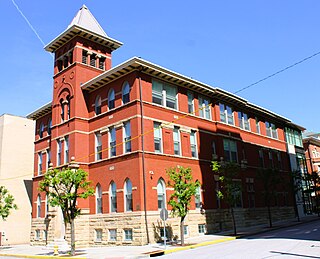
Cathedral Parish School, also known as Wheeling Catholic Elementary and Diocese of Wheeling-Charleston Chancery, was a historic elementary school building located at Wheeling, Ohio County, West Virginia. It was built in 1896–1897, to service the St. Joseph Cathedral parish. A gymnasium addition was built in 1939. It is a three-story brick building, with an elevated first floor. It sits on a sandstone base. It features a center square tower with a pyramidal roof and Late Gothic Revival details.

The Arcola Carnegie Public Library is a Carnegie library located at 407 E. Main St. in Arcola, Illinois. The library was built in 1905 through a $10,000 grant from the Carnegie Foundation. Architect Paul O. Moratz designed the library in the Classical Revival style. The building's front entrance is situated within a Classical gabled portico supported by stone pilasters. The hipped roof of the building features an ornamental cornice along its edge and a cupola at its peak. The building still serves as Arcola's public library and houses a collection of over 18,000 books.

The Streibich Blacksmith Shop is a historic blacksmith shop located at 1 N. Howard St. in Newman, Illinois. The shop was built in 1870 for local blacksmith Ignatius Streibich. Streibich's shop produced farming equipment and domestic items for residents of the area. In addition, Streibich started the first electric power plant in Douglas County in the shop in 1891. While the power plant only lasted a year, it provided a model for future electification efforts in Newman. Streibich retired in 1912, and his son Fred purchased the shop in 1916. Fred Streibich operated the blacksmith shop until his death in 1932. Machinist Kermit O. Tucker operated a shop in the building from 1938 to 1969.
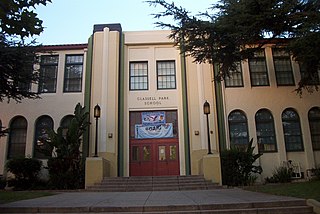
Glassell Park Elementary School is an elementary school listed on the National Register of Historic Places. It is located at 2211 W. Avenue 30, in the Glassell Park neighborhood of Los Angeles, California. It is a PK-6 active school. The principal is Ms. Claudia Pelayo. It is a part of the Los Angeles Unified School District (LAUSD).
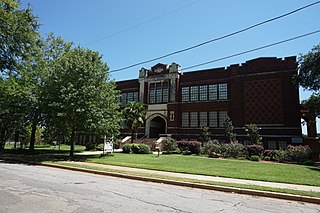
The Museum for East Texas Culture is a museum in Reagan Park in Palestine, Texas.

This is a list of the National Register of Historic Places listings in Washington County, Minnesota. It is intended to be a complete list of the properties and districts on the National Register of Historic Places in Washington County, Minnesota, United States. The locations of National Register properties and districts for which the latitude and longitude coordinates are included below, may be seen in an online map.
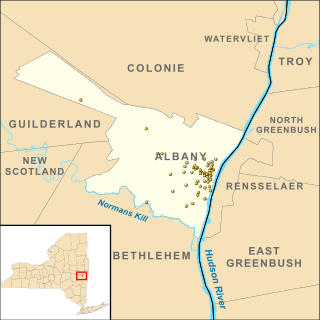
There are 76 properties listed on the National Register of Historic Places in Albany, New York, United States. Six are additionally designated as National Historic Landmarks (NHLs), the most of any city in the state after New York City. Another 14 are historic districts, for which 20 of the listings are also contributing properties. Two properties, both buildings, that had been listed in the past but have since been demolished have been delisted; one building that is also no longer extant remains listed.

There are eight properties listed on the National Register of Historic Places (NRHP) in Linn County, Kansas. Two of the sites are the location of historic events. The Marais des Cygnes Massacre Site is the location of the Marais des Cygnes massacre, an 1858 event during Bleeding Kansas in which pro-slavery advocates kidnapped 11 anti-slavery settlers, killing five of them. John Brown temporarily used the site as a fort, and the property was listed on the NRHP in 1971. The Battle of Mine Creek Site preserves the location of the Battle of Mine Creek, which was fought in 1864 as part of Price's Raid during the American Civil War. Confederate general Sterling Price's army was retreating after being defeated at the Battle of Westport and was attacked by pursuing Union troops. Price's Confederate lost heavily in men and supplies. The site was added to the NRHP in 1973.
The Torrance School, also known as Torrance High School Annex and originally as Torrance Elementary School, is located on the campus of Torrance High School in Torrance, southwestern Los Angeles County, California.

The Bayard School in the Lawrenceville neighborhood of Pittsburgh, Pennsylvania is a building from 1874 and is one of Pittsburgh's oldest surviving school buildings. The school was closed in 1939, along with the nearby Foster School and Lawrence School, when all students were transferred to the new elementary wing of Arsenal Junior High School. It was sold in 1941 and later used as a warehouse. It was listed on the National Register of Historic Places in 1986.

Madison Elementary School is located in Davenport, Iowa, United States. It was nominated for, but not listed on, the National Register of Historic Places on September 9, 2002, with reference number 02001226.

Monroe Elementary School is a building in Davenport, Iowa, United States in the West End. It was nominated for on the National Register of Historic Places on September 9, 2002.

The Lawrence Public School, which is located in the Lawrenceville neighborhood of Pittsburgh, Pennsylvania, was built in 1872 and served as an elementary school, including instruction in the German language.

Marion M. Steen was a Pittsburgh-based architect associated with a number of schools in the area.
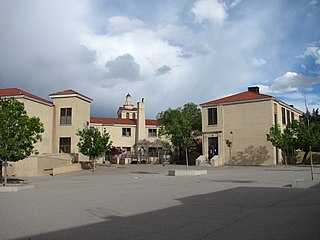
Monte Vista Elementary School is a public elementary school in the Nob Hill neighborhood of Albuquerque, New Mexico, whose campus is listed in the New Mexico State Register of Cultural Properties and the National Register of Historic Places. It is notable as one of the city's best examples of Mediterranean Revival architecture and as the historical focal point of the surrounding neighborhood. It is a part of Albuquerque Public Schools.
Leeds Junior High School was a historic building located in Sioux City, Iowa, United States. High school education in the city dates from 1867, and the first dedicated high school building was completed in 1893. Other schools were built as the district and the city continued to grow. Leeds Junior-Senior High School was built to educate students on the far northeast corner of the city. It was financed by a combination of a local bond referendum and funds from the Public Works Administration. The two story brick building was completed in 1939 in the Art Deco style. Eventually newer high schools and junior high schools were built on the north side of Sioux City, and the building became an elementary school. It was listed on the National Register of Historic Places in 2002. The building was torn down in 2008 when it was replaced by a new school building.






















